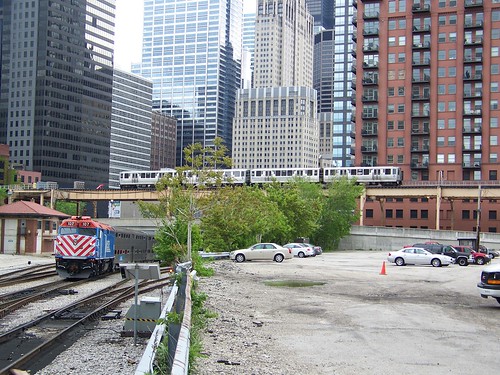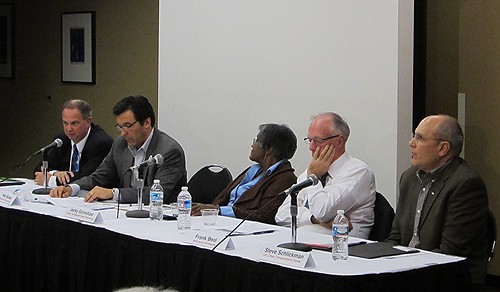How Can Chicagoland Fix Its Regional Transit System?
12:29 PM CST on December 5, 2013
In the wake of the recent Metra patronage scandal, the Regional Transit Authority has come under intense scrutiny. Many journalists, elected officials and policy experts have argued that the current system of separate boards for the CTA, Metra and Pace, overseen by the RTA, lends itself to interagency competition and corruption that gets in the way of improving the area’s transportation network. However, given the complex nature of politics in Illinois, overhauling the system is a daunting task.
Yesterday, UIC’s Great Cities Institute, an urban planning think tank, hosted a roundtable on the future of the RTA and regional transportation planning in Chicagoland. Panelists included Frank Beal, director of Metropolis Strategies, Jacky Grimshaw from the Center for Neighborhood Technology, who also sits on the CTA board, Randy Blankenhorn, director of the Chicago Metropolitan Agency for Planning, Stephen Schlickman, director of UIC’s Urban Transportation Center, and Peter Skosey from the Metropolitan Planning Council.
Early in the discussion, Schlickman gave an eloquent argument for combining the three transit agencies, based on a letter he submitted this fall to the Northeastern Illinois Public Transit Task Force. “The RTA needs a different structure if we’re going to create a world-class transit system for Chicago,” he said. “We’ve been trying to make this multi-agency structure work, and it’s not working as well as it should be. If you look at RTA’s peers, they’re primarily one agency. I would refer you to Boston, New York, and Philadelphia… And throughout this country, regional transit systems are organized as one agency.”
He noted that the complicated structure of the current system creates a lack of accountability. “We have complexities not only of governing but also in service overlap, in capital planning and programming, in the equities, and in the allocation of our finances,” he said. “These topics defy public understanding. And it allows the agencies to shirk responsibility and point fingers at each other when there are problems, such as how do we get a universal farecard. How do we finish Block 37 beyond the $219 million unfinished station. How do we rein in ADA cost escalations. What do we do with the Metra scandals.”
Schlickman argued that the current structure makes it hard for Chicago to address its $19 billion backlog of transportation maintenance and compete with other global cities. “If we’re going to take on the matter of increased funding for the region, and deal with the backlog in capital funding, and expand the system to serve the growing population that we have, we have to speak from one voice,” he said. “I recommend one agency where CTA, Metra, Pace, and ADA paratransit will each have their own operating divisions. The board should be equitably and evenly balanced between the jurisdictions of the city of Chicago, suburban Cook County, and the collar counties, and also we need state representation.”
Skosey said he’s less certain that a single transit agency is necessary for making improvements. “I would disagree that the goal is a unified agency,” he said. “I would submit that it would be nice to have one. I would also then suggest that everything that we are talking about technically can be done with the structure that we have. Clearly it is an impediment though.”
He added that the goal for the region needs to be moving the largest number of people in the most efficient way possible, but we’re nowhere near that goal yet. “It’s difficult to talk about transit prioritization without also talking about larger transportation prioritization as well, because we’re still in a very inequitable situation where highway and roads get a very large share of the funds relative to the benefit that they deliver.”
Skosey noted that bus rapid transit is a great example of prioritizing efficient transportation. “You can see I’m wearing my 'I Love BRT button,'” he said. “In the downtown corridor where the central Loop BRT is proposed, the buses in that corridor account for about four percent of the vehicles. They’re carrying 42 percent of the people. Yet, we still have so much pushback from car drivers and businesses saying, how are people going to get to my store? Well, they’re on the dang bus.”
Blankenhorn said that for transit to move forward in the region, there has to be more emphasis on the user experience. “At the end of the day, people have options,” he said. “If I have to sit [at a bus stop] out in the suburbs in the cold, in a muddy place that doesn’t have a sidewalk and no bus shelter, I am unlikely to wait for that bus. We need to think about, how do we modernize the system to make it the kind of system that people want to use. I often say that the company that makes our railcars is making railcars for China and India, but they look a lot different. They look like something people want to ride in. And I think that’s how we have to think about this, the cars, the information, the fact that we’re still talking about whether we should have Wi-Fi on Metra – we’re almost at the end of 2013 here.”
Grimshaw agreed with Schlickman that there needs to be a new emphasis on fixing existing infrastructure. “Our system is old,” she said. “We date from the 19th Century in terms of the CTA, built in a city where some of the other infrastructure is even older. We have sewers on top of our subways that are creating problems because the sewers leak into the subway.” She noted that new federal and state funding is allowing the transit agencies to start addressing these infrastructure problems.
“And while getting to that state of good repair, I think we have to expand the system,” Grimshaw added. “There are so many people in this region who do not have access to other parts of the region because they do not own a car. Just like in the public school system, we are creating social inequities that have to be addressed. So we can start with what we have, we can build on and rehabilitate what we have, but we can’t stop there, we have to look at expansion as well.”
As dysfunctional as the current regional transportation leadership sometimes appears, things could be worse, Beal said. “There was a period of several years where the head of Metra and the head of CTA would not attend a meeting where the other one was in the room,” Beal said. “I think it’s interesting now, the Ventra rollout problems aside, that Pace and the CTA have worked so diligently to come up with a common farecard system, which is I think a good sign.”
Steven and I will be at Streetsblog's annual editors meeting tomorrow. Streetsblog Chicago will be publishing lightly the rest of the week.
In addition to editing Streetsblog Chicago, John writes about transportation and other topics for additional local publications. A Chicagoan since 1989, he enjoys exploring the city on foot, bike, bus, and 'L' train.
Stay in touch
Sign up for our free newsletter
More from Streetsblog Chicago
Today’s Headlines for Thursday, April 26
The de-facto ban on riverwalk biking is back. What should we do about it?
In the short term, new signage is needed to designate legal areas for cycling on the path. In the long term CDOT should build the proposed Wacker Drive protected bike lane.




